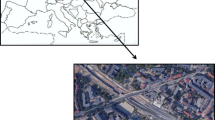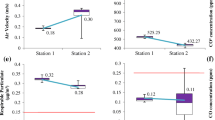Abstract
The purpose of this study was to evaluate the level and composition of bacteria and fungi in the indoor air of an Italian office building equipped with a heating, ventilation and air conditioning (HVAC) system. Airborne bacteria and fungi were collected in three open-space offices during different seasons. The microbial levels in the outdoor air, supply air diffusers, fan coil air flow and air treatment unit humidification water tank were used to evaluate the influence of the HVAC system on indoor air quality (IAQ). A medium–low level of bacterial contamination (50–500 CFU/m3) was found in indoor air. Staphylococcus and Micrococcus were the most commonly found genera, probably due to human presence. A high fungal concentration was measured due to a flood that occurred during the winter. The indoor seasonal distribution of fungal genera was related to the fungal outdoor distribution. Significant seasonal and daily variation in airborne microorganisms was found, underlining a relationship with the frequency of HVAC system switching on/off. The results of this monitoring highlight the role of the HVAC system on IAQ and could be useful to better characterise bacterial and fungal population in the indoor air of office buildings.
Similar content being viewed by others
References
ACGIH (1999). Bioaerosol: Assessment and control (1st ed.). Cincinnati, OH: American Conference of Governmental Industrial Hygienists.
Avidano, L., Gamalero, E., Cossa, G. P., & Carraro, E. (2005). Characterisation of soil health in an Italian polluted site by using microorganisms as bioindicators. Applied Soil Ecology, 30, 21–33. doi:10.1016/j.apsoil.2005.01.003.
Burge, H. A., Pierson, D. L., Groves, T. O., Strawn, K. F., & Mishra, S. K. (2000). Dynamics of airborne fungal populations in a large office building. Current Microbiology, 40, 10–16. doi:10.1007/s002849910003.
CEC (1993). Indoor air quality & its impact on man. Biological particles in indoor environments. Commission of European Communities. Report 12. Cost Project 613. EUR. 14988 EN.
Clarke, D., & Nikkel, D. (1995). Office air: A worker’s guide to air quality in offices, schools, and hospitals. Report of the Federal–Provincial Advisory Committee on Environmental and Occupational Health, Canada. 93-EHD-174.
EN ISO (1999). Water quality—Enumeration of culturable micro-organism—colony count by inoculation in a nutrient agar culture medium. International Organization for Standardization (EN ISO Standard 6222–1999).
Huang, R., Agranovski, I., Pyankov, O., & Grinshpun, S. (2008). Removal of viable bioaerosol particles with a low-efficiency HVAC filter enhanced by continuous emission of unipolar air ions. Indoor Air, 18, 106–112. doi:10.1111/j.1600-0668.2007.00512.x.
Huttunen, K., Rintala, H., Hirvonen, M. R., Vepsäläinen, A., Hyvärinen, A., Meklin, T., et al. (2008). Indoor air particles and bioaerosols before and after renovation of moisture-damaged buildings:the effect on biological activity and microbial flora. Environmental Research, 107, 291–298. doi:10.1016/j.envres.2008.02.008.
Hyvärinen, A., Reponen, T., Husman, T., Ruuskanen, J., & Nevalainen, A. (1993). Characterizing mold problem buildings: Concentrations and flora of viable fungi. Indoor Air, 3, 337–343. doi:10.1111/j.1600-0668.1993.00017.x.
ISO (1998). Water quality-detection and enumeration of Legionella. International Organization for Standardization (ISO Standard 11731–1998).
Jo, W. K., & Seo, Y. J. (2005). Indoor and outdoor bioaerosol levels at recreation facilities, elementary schools, and homes. Chemosphere, 61, 1570–1579. doi:10.1016/j.chemosphere.2005.04.103.
Jones, A. P. (1999). Indoor air quality and health. Atmospheric Environment, 33, 4535–4564. doi:10.1016/S1352-2310(99)00272-1.
Kim, K. Y., & Kim, C. N. (2007). Airborne microbiological characteristics in public buildings of Korea. Building and Environment, 42, 2188–2196. doi:10.1016/j.buildenv.2006.04.013.
Law, A. K. Y., Chau, C. K., & Chan, G. Y. S. (2001). Characteristics of bioaerosol profile in office buildings in Hong Kong. Building and Environment, 36, 527–541. doi:10.1016/S0360-1323(00)00020-2.
Lee, T., Grinshpun, S. A., Martuzevicious, D., Adhikari, A., Crawford, C. M., Luo, J., et al. (2006). Relationship between indoor and outdoor bioaerosols collected with a button inhalable aerosol sampler in urban homes. Indoor Air, 16, 37–47. doi:10.1111/j.1600-0668.2005.00396.x.
Loftness, V., Hakkinen, B., Adan, O., & Nevalainen, A. (2007). Elements that contribute to healthy building design. Environmental Health Perspectives, 115, 965–970.
Maroni, M., Bersani, M., Cavallo, D., Anversa, A., & Alcini, D. (1993). Microbial contamination in buildings: Comparison between seasons and ventilation systems. In O. Seppanen (Ed.), Proceedings of indoor air’93, Helsinki, international conference on indoor air, quality and climate (Vol. 4, pp. 137–142).
Mendell, M. J., Lei-Gomez, Q., Mirer, A. G., Seppänen, O., & Brunner, G. (2008). Risk factors in heating, ventilating, and air-conditioning systems for occupant symptoms in US office buildings: The US EPA BASE study. Indoor Air, 18, 301–316. doi:10.1111/j.1600-0668.2008.00531.x.
Montanaro, A. (1997). Indoor allergens: Description and assessment of health risks. In E. J. Bardana, & A. Montanaro (Eds.), Indoor air pollution and health. New York: Marcel Dekker.
Nathanson, T. (1995). Indoor air quality in office buildings: A technical guide. Report of the Federal–Provincial Advisory Committee on Environmental and Occupational Health, Canada. 93-EHD-166.
Nevalainen, A. (1989). Bacterial aerosols in indoor air. Ph.D. diss, University of Kuopio, Finland.
Nevalainen, A., & Seuri, M. (2005). Of microbes and men. Indoor Air, 15, 58–64. doi:10.1111/j.1600-0668.2005.00344.x.
Parat, S., Perdrix, A., Fricker-Hidalgo, H., Saude, I., Grilloy, R., & Baconnier, P. (1997). Multivariate analysis comparing microbial air content of an air-conditioned building and a naturally ventilated building over one year. Atmospheric Environment, 31, 441–449. doi:10.1016/S1352-2310(96)00212-9.
Pasanen, A., Niininen, M., Kalliokoski, P., Nevalainen, A., & Jantunen, M. (1992). Airborne Cladosporium and other fungi in damp versus reference residences. Atmospheric Environment, 26, 121–124.
Pastuszka, J. S., Paw, U. K. T., Lis, D. O., Wlazlo, A., & Ulfig, K. (2000). Bacterial and fungal aerosol in indoor environment in Upper Silesia, Poland. Atmospheric Environment, 34, 3833–3842. doi:10.1016/S1352-2310(99)00527-0.
Rao, C. Y., Riggs, M. A., Chew, G. L., Muilenberg, M. L., Thorne, P. S., Van Sickle, D., et al. (2007). Characterization of airborne molds, endotoxins, and glucans in homes in New Orleans after hurricanes Katrina and Rita. Applied and Environmental Microbiology, 73, 1630–1634. doi:10.1128/AEM.01973-06.
Reynolds, S. J., Black, D. W., Borin, S. S., Breuer, G., Burmeister, L. F., Fuortes, L. J., et al. (2001). Indoor environmental quality in six commercial office buildings in the midwest United States. Applied Occupational and Environmental Hygiene, 16, 1065–1077. doi:10.1080/104732201753214170.
Riggs, M. A., Rao, C. Y., Brown, C. M., Van Sickle, D., Cummings, K. J., Dunn, K. H., et al. (2008). Resident cleanup activities, characteristics of flood-damaged homes and airborne microbial concentrations in New Orleans, Louisiana, October 2005. Environmental Research, 106, 401–409. doi:10.1016/j.envres.2007.11.004.
Sampò, S., & Luppi Mosca, A. M. (1988). Fungi from the walls of a flat in Turin. Allionia, 28, 175–184.
Sampò, S., & Luppi Mosca, A. M. (1989). A study of the fungi occurring on 15th century frescoes in Florence, Italy. International Biodeterioration, 25, 343–353.
Schwab, C. J., & Strauss, D. C. (2004). The roles of Penicillium and Aspergillus in sick building syndrome. Advances in Applied Microbiology, 55, 215–238.
Sen, B., & Asan, A. (2009). Fungal flora in indoor and outdoor air of different residential houses in Tekirdag City (Turkey): Seasonal distribution and relationship with climatic factors. Environmental Monitoring and Assessment. doi:10.1007/s10661-008-0262-1.
Seppänen, O., & Fisk, W. J. (2002). Association of ventilation system type with SBS symptoms in office workers. Indoor Air, 12, 98–112. doi:10.1034/j.1600-0668.2002.01111.x.
Sessa, R., Di Pietro, M., Schiavoni, G., Santino, I., Altieri, A., Pinelli, S., et al. (2002). Microbiological indoor air quality in healthy buildings. The New Microbiologica, 25, 51–56.
Shelton, B. G., Kirkland, K. H., Flanders, W. D., & Morris, G. K. (2002). Profiles of airborne fungi in buildings and outdoor environments in the United States. Applied and Environmental Microbiology, 68, 1743–1753. doi:10.1128/AEM.68.4.1743-1753.2002.
Srikanth, P., Sudharsanam, S., & Steinberg, R. (2008). Bio-aerosols in indoor environment: Composition, health effects and analysis. Indian Journal of Medical Microbiology, 26, 302–312.
Stetzenbach, L. D. (1997). Introduction to aerobiology. In C. J. Hurst, G. R. Knudsen, M. J. Mc Inerney, & L. D. Stetzenbach (Eds.), Manual of environmental microbiology. Washington, DC: ASM Press.
Stanley, N. J., Kuehn, T. H., Kim, S. W., Raynor, P. C., Anantharaman, S., Ramakrishnan, M. A., et al. (2008). Background culturable bacteria aerosol in two large public buildings using HVAC filters as long term, passive, high-volume air samplers. Journal of Environmental Monitoring, 10, 474–481. doi:10.1039/b719316e.
Shoemaker, R. C., & House, D. E. (2006). Sick building syndrome (SBS) and exposure to water-damaged buildings: Time series study, clinical trial and mechanisms. Neurotoxicology and Teratology, 28, 573–588. doi:10.1016/j.ntt.2006.07.003.
Tringe, S. G., Zhang, T., Liu, X., Yu, Y., Lee, W. H., Yap, J., et al. (2008). The airborne metagenome in an indoor urban environment. PLoS ONE, 3, 1–10.
Tsai, F. C., & Macher, J. M. (2005). Concentrations of airborne culturable bacteria in 100 large US office buildings from the BASE study. Indoor Air, 15, 71–81. doi:10.1111/j.1600-0668.2005.00346.x.
Von Arx, J. A. (1981). The genera of fungi sporulating in pure culture. Lubrecht & Cramer Ltd. Vaduz, Germany.
Wu, P. C., Li, Y. Y., Chiang, C. M., Huang, C. Y., Lee, C. C., Li, F. C., et al. (2005). Changing microbial concentrations are associated with ventilation performance in Taiwan’s air-conditioned office buildings. Indoor Air, 15, 19–26. doi:10.1111/j.1600-0668.2004.00313.x.
Author information
Authors and Affiliations
Corresponding author
Electronic Supplementary Material
Below is the link to the electronic supplementary material.
Rights and permissions
About this article
Cite this article
Bonetta, S., Bonetta, S., Mosso, S. et al. Assessment of microbiological indoor air quality in an Italian office building equipped with an HVAC system. Environ Monit Assess 161, 473–483 (2010). https://doi.org/10.1007/s10661-009-0761-8
Received:
Accepted:
Published:
Issue Date:
DOI: https://doi.org/10.1007/s10661-009-0761-8




